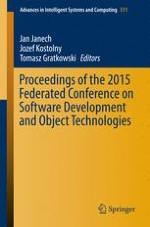This book presents the proceedings of the International Conference SDOT which was organized at the University in Žilina, Faculty of Management Sciences and Informatics, Slovak Republic in November 19, 2015. The conference was truly international both in terms of the amount of foreign contributions and in terms of composition of steering and scientific committees. The book and the conference serves as a platform of professional exchange of knowledge and experience for the latest trends in software development and object-oriented technologies (theory and practice). This proceedings present information on the latest developments and mediate the exchange of experience between practitioners and academia.
